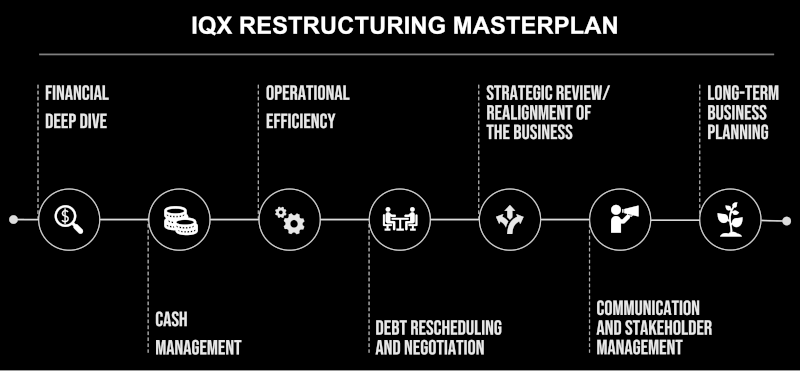
RESTRUCTURING ADVICE
Restructuring is often the key to ensuring the long-term success of a company. It may become necessary to respond to market changes, increase efficiency potential or regain financial stability. Our job is to support you in these crucial phases. With in-depth know-how and a clear eye for what's important, we accompany you through the entire process - from analysis to strategy development and implementation. Together we create the basis for a sustainable and future-proof corporate structure.
Restructuring a company can be an exceptionally complex process with numerous challenges. For a successful transformation, managers often have to overcome enormous hurdles and ensure that the changes actually take effect.

Your contact at IQX:
Reinhold Trummer
+43 676 677 30 85
This email address is stez protected from spambots. You need javaScript Enabled to view it.
Operational restructuring: An indispensable component of successful restructuring projects
In times of economic uncertainty and technological changes, companies often face existential challenges. In order to overcome crises and prepare for the future, comprehensive restructuring is often unavoidable. While the focus is often on financial and strategic aspects, operational restructuring should be considered an integral part of such projects. It is crucial for ensuring that the planned changes reach deep into the organization and have a lasting effect. But what makes operational restructuring so essential?
A successful restructuring must not only focus on reducing costs or improving the financial structure. It is often overlooked that many problems lie in the operational area, where inefficient processes lead to wasted time and resources. Operational restructuring aims to identify and eliminate these inefficiencies.
For example, outdated IT systems or manual, error-prone processes can severely hinder a company's operations. This is where operational restructuring comes in: Significant efficiency gains can be achieved through the digitalization of processes, the automation of routine tasks and the introduction of more agile working methods. These measures not only reduce costs in the short term, but also contribute to competitiveness in the long term because they create flexibility and scalability.
In many restructuring projects, the question of competitiveness is often neglected. But especially in a dynamic market environment, it is crucial that a company can quickly adapt to changing conditions. Operational restructuring makes it possible not only to improve internal processes, but also to strengthen the position in the market.
An example of this is supply chain optimization: A company that makes its supply chains more efficient can respond more quickly to fluctuations in demand and serve its customers better. This gives it a clear competitive advantage. At the same time, lean and well-coordinated production makes it possible to react more quickly to market trends or technical innovations and to use them to your advantage.
Extensive strategic and financial plans are often drawn up in restructuring projects, but these are only inadequately implemented in operational business. Operational restructuring ensures that the decisions made actually have an impact on day-to-day business and do not just exist on paper.
For example, new management structures or cost reduction plans could come to nothing without corresponding operational adjustments. Operational restructuring puts these plans into practice by embedding the necessary changes in processes and structures. This ensures that the organization as a whole is able to meet new requirements and integrate changes as part of its daily operations. This is particularly important to ensure that the restructuring is not just a short-term improvement, but has a lasting effect.
An often overlooked aspect of restructuring projects is the role of employees. Change can create fears and insecurities that lead to resistance and a decrease in motivation. However, through targeted operational restructuring, employees can be actively involved in the change process and their motivation can be strengthened.
Operational changes, such as improving work processes, clearer responsibilities or the use of modern technologies, can make everyday life easier for employees and enable them to work more productively. When employees see that the restructuring actually benefits them and is not just an abstract management measure, their willingness to actively participate increases. In the long term, this not only contributes to improving the corporate culture, but also to higher efficiency and quality of work.
As a rule, a main goal of restructuring projects is to reduce costs. But while financial restructuring often focuses on savings through workforce reductions or closing locations, operational restructuring offers an opportunity to optimize cost structures in a more sustainable way.
By optimizing processes and eliminating inefficiencies, companies can significantly reduce their operational costs without necessarily having to make layoffs or reduce product quality. Lean and well-thought-out processes mean that resources are used more efficiently - be it in production, logistics or administration. Examples of this include the introduction of lean management methods or the automation of recurring, low-value-adding activities.
While financial restructuring can often achieve short-term success by restructuring debt or raising capital, the question of long-term stability remains. Operational restructuring lays the foundation for sustainable corporate success by ensuring that the company overcomes not only financial but also structural and procedural challenges.
A company that is able to continually improve its operations not only remains competitive, but is also better prepared for future challenges. This can take the form of improved reaction times to market changes, higher customer satisfaction through optimized services or better innovation management. In this way, the operational restructuring creates space for future growth and strengthens the company's position in the market in the long term.
The IQX Restructuring Master Plan
Extremely important - but not quantifiable - are the challenges of overcoming the “cultural resistance” and the “need for over-communication” of employees in restructuring phases.
Employees often resist change due to fear of the unknown, job insecurity and disruption of established routines. This resistance can manifest itself in reduced productivity, increased turnover and a decline in morale.
Inconsistent messaging and lack of support from middle/lower levels of leadership can exacerbate resistance. It is crucial to ensure that leaders at all levels are aligned and actively support the restructuring.
Failure to communicate the reasons for the restructuring, the benefits and the impact on employees can lead to confusion and distrust. Transparent and frequent communication is essential to mitigating these issues.
The IQX GROUP approach to restructuring a company / individual divisions (with liquidity problems) is to create a comprehensive master plan to address immediate (cash flow) problems while creating a basis for long-term (financial) stability.

The IQX GROUP MASTER PLAN is based on the points presented below, which of course - depending on the scope of the restructuring - can only include partial aspects.
Phases and content of a restructuring
1. “DEEP DIVE” on the financial situation
Critical review thorough analysis
- the annual financial statements for the last 3 years, the profit/loss statement on a monthly basis for the last 12 months
- the cash flow forecasts for the next 3, 6 and 12 months
- of debt obligations
- of the company's current assets
- the solvency of the company in accordance with the legal requirements (examination of the avoidance of delay in insolvency)
Comprehensive root cause analysis of liquidity problems (carried out by relevant experts from the IQX GROUP)
- excessive debt
- inefficient processes
- Analysis of product portfolio (product result calculation)
- non-competitive cost structures
- incorrect pricing structure for customers
- declining sales
- Market changes
- …..
Start of creating a continued existence forecast
2. Short-term, stringent cash management
Introduction of strict cash flow management to maintain or improve liquidity,
- the exclusive approval of every payment by the managing director / IQX “Chief Restructing Officer”
- delaying payments to suppliers in coordination with them
- the acceleration of debt collection
- negotiating extended payment terms
- Minimizing all raw materials, semi-finished products and finished parts inventories
Prioritizing payments to critical suppliers to maintain critical supplies and relationships
Identifying and implementing short-term financing options to cover immediate liquidity needs:
- Expansion of credit lines
- Factoring
- Consider asset-based loans
- “Sell and lease back”
- ……
Incorporation of the created cash flow program including the measures taken into the continued existence forecast
3. Massive improvements in operational efficiency - RESTRUCTURING
Optimize operations to reduce costs and improve efficiency. This may include, but is not limited to, restructuring departments, renegotiating contracts, or outsourcing non-core functions.
Identify and eliminate wasteful expenses or redundant processes (e.g. process mining, lean office,...)
Implement lean management principles to optimize any type of resource utilization and minimize waste -> see IQX OPEX program
Incorporation of all decided restructuring measures including the expected improvements to company results, cash flow,...
4. Debt restructuring and negotiation
Intensive negotiations with creditors to renegotiate the terms of existing debts, e.g. b.
- to extend the terms
- to lower interest rates
- the possibility of securing (partial) debt relief.
Finding and evaluating debt consolidation or refinancing options to reduce overall interest costs and improve cash flow.
Consideration of equity financing such as through existing shareholders, convertible bonds,… in order to reduce the debt burden
Incorporation of all debt restructuring – results and improvements in equity financing into the continued existence forecast

5. Strategic review/realignment of the business
Evaluating the company's market position, competitive landscape and growth prospects.
Identifying strengths and opportunities for diversification - in the medium term with the potential for expansion.
The assessment of underperforming assets, products, production facilities with the aim
- a sale
- a cessation of production
- a shutdown
Completion of the continued existence forecast and presentation to the creditors for acceptance
Intensive cooperation with all creditors and important shareholders to generate approval for the continued existence forecast
6. Communication and stakeholder management
Ensuring and maintaining transparent communication with employees, suppliers, creditors and other stakeholders about the company's financial situation and restructuring efforts.
Stringent monthly reporting to ensure adherence to target paths, shown in the continued existence forecast
Addressing concerns and creating a climate of trust to maintain support from all creditors and shareholders.
7. Long-term business planning
Developing a viable, sustainable business model that is oriented towards future market trends and customer requirements.
Developing innovations and new developments to differentiate products or services from competitors and to open up new sources of income in the future.
Implement robust risk management to avoid future liquidity risks and create an agile corporate structure.